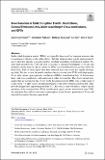Reverberation in Tidal Disruption Events: Dust Echoes, Coronal Emission Lines, Multi-wavelength Cross-correlations, and QPOs
Author(s)
van Velzen, Sjoert; Pasham, Dheeraj R.; Komossa, Stefanie; Yan, Lin; Kara, Erin A.
Download11214_2021_Article_835.pdf (2.405Mb)
Publisher with Creative Commons License
Publisher with Creative Commons License
Creative Commons Attribution
Terms of use
Metadata
Show full item recordAbstract
Abstract
Stellar tidal disruption events (TDEs) are typically discovered by transient emission due to accretion or shocks of the stellar debris. Yet this luminous flare can be reprocessed by gas or dust that inhabits a galactic nucleus, resulting in multiple reverberation signals. Nuclear dust heated by the TDE will lead to an echo at infrared wavelengths (1-10 μm) and transient coronal lines in optical spectra of TDEs trace reverberation by gas that orbits the black hole. Both of these signal have been detected, here we review this rapidly developing field. We also review the results that have been extracted from TDEs with high-quality X-ray light curves: quasi periodic oscillations (QPOs), reverberation lags of fluorescence lines, and cross-correlations with emission at other wavelengths. The observational techniques that are covered in this review probe the emission from TDEs over a wide range of scales: from
∼
1
$\sim 1$
light year to the innermost parts of the newly formed accretion disk. They provide insights into important properties of TDEs such as their bolometric output and the geometry of the accretion flow. While reverberation signals are not detected for every TDE, we anticipate they will become more commonplace when the next generation of X-ray and infrared instruments become operational.
Date issued
2021-07-01Department
MIT Kavli Institute for Astrophysics and Space ResearchPublisher
Springer Netherlands
Citation
Space Science Reviews. 2021 Jul 01;217(5):63
Version: Final published version